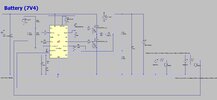Hi,
We want to disable our Buck (LTC7803) then re-enable it, and have it come back on within 1ms......the attached LTspice shows that pulling down the TRACK pin is the best way of achieving this.
Would you agree this is the best way?......Alternatively pulling the RUN pin to between 0.7V and 1.2V is the other way, but results in massive overshoot when re-enabled...would you say this is correct, as often they dont bother modelling the RUN/TRACK pins correctly in LTspice?
We want to disable our Buck (LTC7803) then re-enable it, and have it come back on within 1ms......the attached LTspice shows that pulling down the TRACK pin is the best way of achieving this.
Would you agree this is the best way?......Alternatively pulling the RUN pin to between 0.7V and 1.2V is the other way, but results in massive overshoot when re-enabled...would you say this is correct, as often they dont bother modelling the RUN/TRACK pins correctly in LTspice?
Attachments
Last edited:


